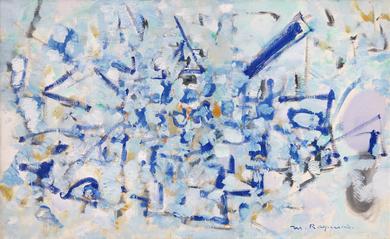Exploring the concept of “Abstract Impressionism” often proposed as a distinction between European abstraction and American Abstract “Expressionism”.
When the critic Pierre Guéguen referred to André Lanskoy’s “impressionnisme abstrait” in the catalogue of the artist’s 1957 exhibition at Galerie Louis Carré, it was a much debated term, often proposed as a distinction between European abstraction and American Abstract “Expressionism”. The implication being that European abstract painters more often derived their inspiration from the external optical perception of the physical world, as opposed to the American “Ab Ex” self-referential narrative of manifesting the inner emotions of the artist’s psyche or “soul”.
In 1958 the Arts Council held an exhibition titled “Abstract Impressionism” consisting of European orientated painters including Nicolas de Stael, Joan Mitchell, Sam Francis, Patrick Heron, Ivon Hitchens and Peter Lanyon, all typically deriving inspiration from the natural world. “My painting is abstract, but it is also a landscape”, wrote Joan Mitchell.
Through the range of artworks presented in HFA’s exhibition we re-visit the idea of “Abstract Impressionism” and explore the extent to which the artists drew on the physical world for their inspiration in European post-war abstraction.
Marie Raymond’s large apparently abstract composition of a myriad of brush strokes in varying blues from 1962 is titled “Montagne”, tempting us to identify elements of a landscape, perhaps naturally progressing from Cezanne’s “Mont Sainte-Victoire” series.
Colourist James Pichette’s 1955 “Soleil Levant”, with citrus rays against blocks of azure, conveys the artist’s response to that which inspired Monet’s seminal “Impression Sunrise”. While Edmond Boissonnet’s series of vigorous compositions inspired by the Bassin d’Archachon, a vast natural lagoon on the west coast of France, where he sought to capture the elements in varying light and weather, draws parallels with Monet’s multiple depictions of haystacks, and Rouen Cathedral.
Presented with Jean Le Moal’s 1954 large square canvas of interwoven arabesques in contrasting violet blues and burnt oranges, we initially immerse ourselves in the rich colour combinations and linear web before the title “Les Arbres” evokes a figurative interpretation, as well as an art historical proposition referencing Mondrian’s arching trees.
Camile Bryen’s vertical composition “Fomalhaut” from 1955 exhibited at the Stedelijk Museum in 1957 could equally appear abstract or as a galactic panorama depending on the viewer’s knowledge of astronomy, the title referring to a star in the constellation Piscis Austrinus.
Christine’s Boumeester allowed herself to fluctuate in and out of abstraction creating a mystical dreamlike sensation. “Paysage aux Chevaux” from 1953 presents a nebulous mixture of yellows and greens entirely abstract but for the occasional distinct equine form. Similarly Reynold Arnould’s “Pont de Neuilly” would be sufficiently satisfying as an abstract series of geometric forms, but the interpretation as a bridge provokes a real world narrative.
We hope the artworks presented through the lens of this exhibition at HFA stimulate interesting insights into the artists’ motivation, and the significance of differing paths to abstraction, in reference to art historical terminology.

